Morris & Fan. Reservoir Sedimentation Handbook
Подождите немного. Документ загружается.

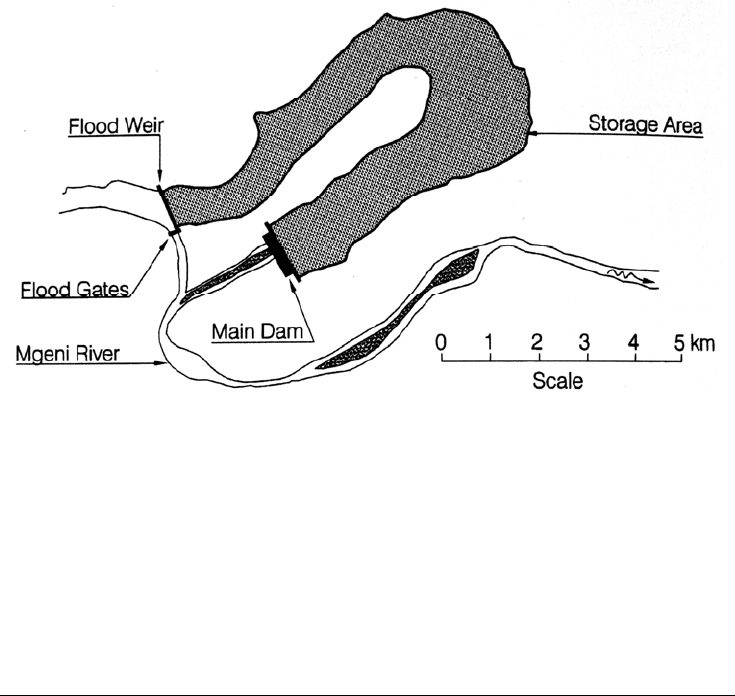
SEDIMENT ROUTING 13.16
FIGURE 13.9 Sediment bypass configuration at Nagle Reservoir in South Africa (afte
r
A
nnandale, 198
7
)
instance the forebay receives runoff from the main stream and from an intake on another
stream. Water enters the storage afterbay only after it has passed through the forebay area,
which acts as a sedimentation basin. Sediment deposited in the forebay is removed by
intermittent flushing.
13.7 OFF-STREAM RESERVOIRS
13.7.1 Technique
An off-stream reservoir is any impoundment constructed off the main river and which is
filled with diverted water of low sediment concentration. Several methods may be used to
reduce the sediment load on the offstream reservoir: (1) sediment-laden discharge from
large floods can be partially or entirely excluded from the reservoir by limiting the
hydraulic capacity of the intake structure or selective operation of the intake gate, (2) the
intake structure can be designed to exclude coarse sediments, and (3) the diversion dam
can be operated as a sediment trap for diverted water, with trapped sediment being
subsequently removed by flushing. An off-stream reservoir can be constructed as a diked
impoundment, using a conventional dam across a small tributary with low sediment yield,
or on the floodplain paralleling the main channel. These strategies are schematically
illustrated in Fig. 13.11. Tributary arms of existing reservoirs may also receive relatively
little sediment compared to the main river branch, thereby acting as off-channel storage
pools within existing impoundments.
Since inflow can be controlled at the diversion point, an off-stream reservoir does not
require a large and costly spillway structure. The reduced sediment loading can largely
eliminate the need to provide a sediment storage pool and reduces future maintenance
costs (e.g., dredging), further reducing costs compared to a conventional reservoir.
Because it never receives high sediment loads, the off-stream reservoir can also provide
consistently high quality water to quality-sensitive users such as municipal water supplies.
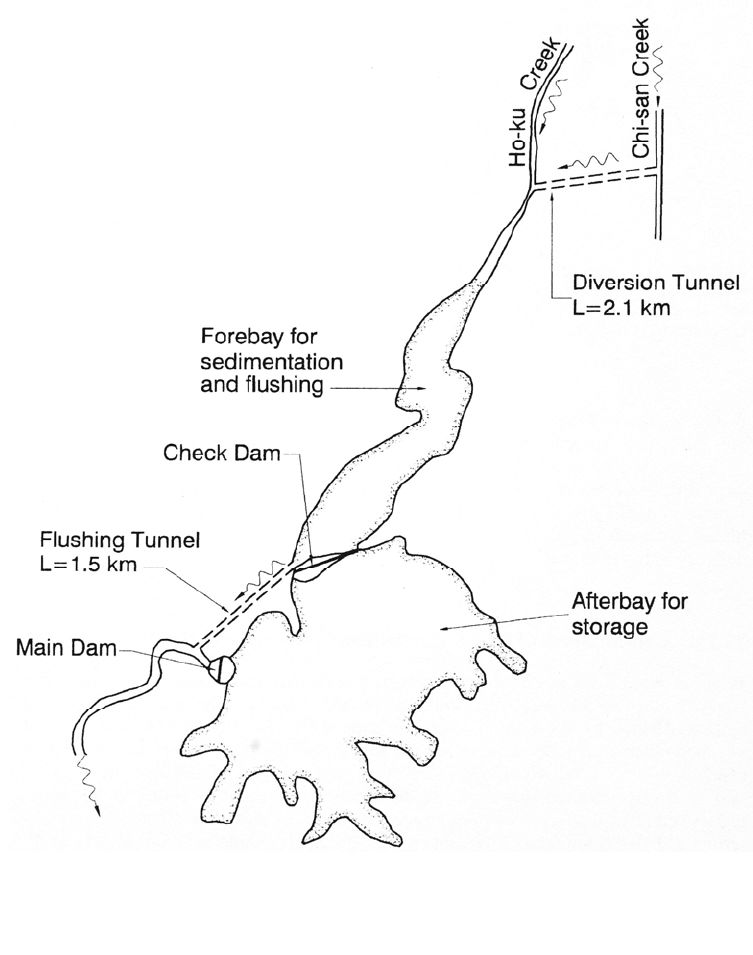
SEDIMENT ROUTING 13.17
FIGURE 13.10 Proposed Nan-Hwa reservoir in Taiwan, showing the compartment of the reservoi
r
into an upstream forebay for sediment tra
p
ping and diversion, and an afterbay for sediment storage
(after Hwang, undated).
Of
f-stream reservoirs can also provide important environmental benefits compared to
conventional structures. Depending on the design, they may not require a large instream
barrier at the intake site, and the downstream transport of bed material can be maintained.
13.7.2 Application
Of the 33 major reservoirs in Taiwan, 9 are offstream structures designed to bypass
sediment. Data on two of these structures were summarized by Wu (1991), who reported
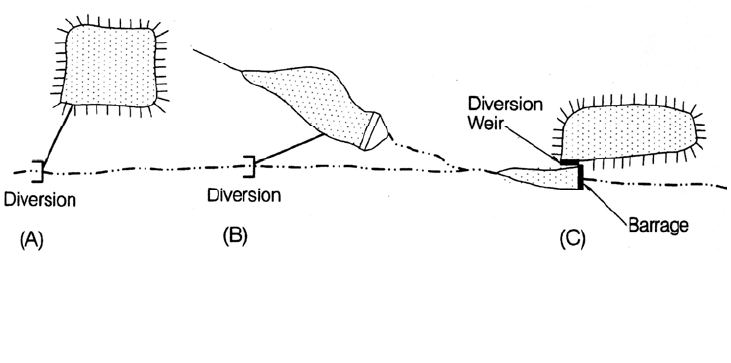
SEDIMENT ROUTING 13.18
FIGURE 13.11 Alternative configurations for off-stream reservoirs. Limited-capacity intake
diverting flow into: (a) an excavated or diked impoundment, or (b) an impoundment located on a
small tributary with a low sediment load. (c) Use of a barrage to control flow over a diversion wei
r
and into an off-stream impoundment, as suggested by Urlapov (1977).
t
hat at Sun Moon Reservoir, 49.5 percent of total streamflow was diverted into the
reservoir but only 3.5 percent of the stream sediment was diverted. At Coral Lake
Reservoir 29.6 percent of the streamflow was diverted but only 12.2 percent of the
sediment. The large difference in sediment diversion at these two structures was attributed
to the configuration of the diversion dam. The diversion dam at the Sun Moon Reservoir
had a higher sediment trap efficiency, and was thus more efficient in preventing sediment
delivery to the reservoir.
13.7.3 Computation of Reservoir Yield and Sediment Exclusion
Whereas yield from an on-stream reservoir can be expressed as a function of storage
capacity alone by a storage-yield curve, in the off-stream configuration reservoir yield is
also affected by the limited hydraulic capacity of the stream diversion and conveyance
channel or pipeline between the intake and the reservoir. A larger diversion capacity will
allow the off-stream reservoir to refill more rapidly, which can be important on flashy
streams. However, the increased intake capacity comes at the cost of higher sediment
loading because a larger percentage of total diversions will consist of sediment-laden flood
flows. Flow into the off-stream impoundment will always be limited to the lesser of
streamflow or the diversion capacity. In the sediment bypass system, this inflow constraint
does not exist because the reservoir impounds the original stream channel and inflow rate
is not restricted.
To minimize sediment loading, the off-stream reservoir should be designed to receive
no additional inflow when it is full. Sediment inflow during floods is thus limited by both
the restricted intake capacity and the higher probability of the reservoir being full during
flood periods. For further reduction in sediment inflow, a gate could be operated at the
stream diversion to manually or automatically select water for diversion or exclusion on
the basis of reservoir level, stream turbidity, and possibly other criteria.
A performance comparison of a conventional on-stream impounding reservoir and an
off-stream reservoir was made using 21 years of daily discharge data from the USGS gage
at Rio Fajardo, Puerto Rico (Morris, 1996). This small (38.6 km
2
) moist watershed
receives about 2500 mm/yr of rainfall which is rather well distributed throughout the year,
although streamflow is flashy. Sediment yield is 814 t/km
2
/yr, and a rating curve of
sediment concentration of the form C
mg/L
= aQ
b
was established for the four available years

SEDIMENT ROUTING 13.19
of mean daily discharge and load data published by the USGS. A daily simulation analysis
was run to determine the yield available on 99 percent of the days in the 21-year dataset,
and to compute sediment accumulation in the reservoir from the average daily suspended
sediment concentration, the volume of water diverted each day, and assuming 100 percent
trap efficiency in the off-stream reservoir.
The simulated system consisted of a stream diversion having various capacities,
combined with various storage volumes in the off-stream storage compartment (Fig.
13.11a). Simulation results are summarized in Table 13.1, expressing both storage and
yield values as the dimensionless fraction of the average daily flow (ADF) over the
simulation period. By comparison, the 99 percent run-of-river flow exceedance at this
gage station for the analyzed dataset is 0.057 x ADF. Sediment inflow is expressed as
percent of total sediment load. For reservoirs on this stream with storage volumes up to 90
days of mean flow (25 percent of mean annual runoff), there was essentially no difference
in yield between a conventional reservoir and an off-stream reservoir with an inlet rated at
3 x ADF. Use of a smaller inlet capacity rated at 1 x ADF produced a small decrease in
yield and a larger decrease in sediment inflow as compared to the larger inlet. The smallest
inlet, rated at 0.5 x ADF, had a significant impact on yield for larger storage volumes but
not for smaller. By comparison, a 100-year sediment pool for a conventional reservoir at
this site with a 90 percent trap efficiency will require 5.6 Mm
3
of storage volume,
equivalent to 33 days of ADF.
Depending on the configuration, sediment inflow into this off-stream reservoir is 80 to
98 percent less than a conventional (onstream) reservoir at the same location. For a given
yield, the off-stream reservoir can be much smaller than the conventional reservoir
because the sediment pool is practically eliminated. While sediment accumulation is not
entirely eliminated from the off-stream reservoir, the rate of accumulation is reduced to
such low levels that activities such as dredging become economically attractive. This
illustrates that in some streams a dramatic reduction in sediment loading can be achieved
using off-stream storage, without a significant penalty in terms of yield.
TABLE 13.1
Yield and Sediment Load for Conventional and Off-Stream Reservoir, Río
Fajardo, Puerto Rico
Reservoir Configuration
Reservoir
storage
volume,
days at
ADF
A
yield,
ADF
B
Yield,
ADF
B
Load,
%
C
Yield,
ADF
C
Load,
%
D
Yield,
ADF
D
Load,
%
5 0.145 0.145 2.1 0.145 2.1 0.140 2.1
10 0.220 0.220 3.5 0.220 3.5 0.220 3.5
15 0.285 0.285 5.2 0.285 4.9 0.275 4.6
30 0.425 0.425 10.2 0.385 7.7 0.340 5.9
60 0.545 0.545 16.3 0.500 11.1 0.380 6.7
90 0.610 0.605 20.5 0.530 12.0 0.390 6.8
Notes: ADF = Average daily flow = 1.93 m
3
/s. Storage volume is expressed as days of discharge at ADF,
where 1 day ADF = 166,700 m
3
.
Load = percent of total river suspended sediment load trapped over the simulation period.
A = conventional impounding reservoir, sediment inflow is 100% of river load.
B = off-stream reservoir, inlet capacity = 3.0 x ADF.
C = off-stream reservoir, inlet capacity = 1.0 x ADF.
D = off-stream reservoir, inlet capacity = 0.5 x ADF.
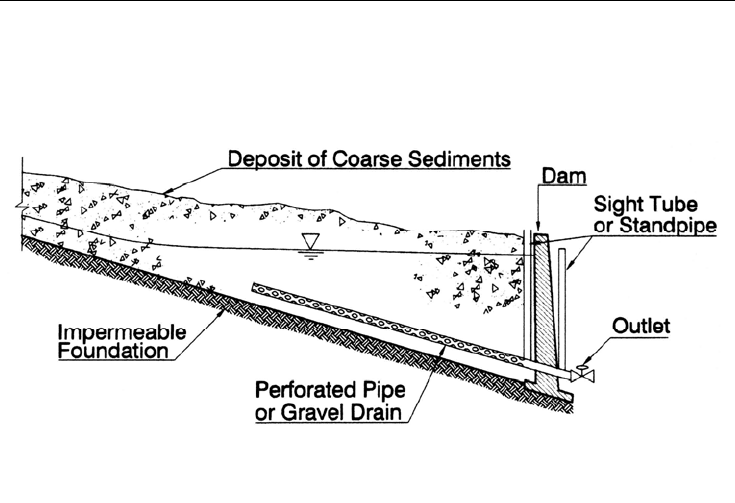
SEDIMENT ROUTING 13.20
13.8 SUBSURFACE RESERVOIR
Deposits of coarse sediment contain voids which can store water, and under favorable
conditions a trap dam may be constructed to accumulate coarse sediment, extracting water
from the subsurface storage by a pipe through the base of the dam and which extends
through the permeable deposits (Fig. 13.12). Use of these systems as for small local water
FIGURE 13.12 Schematic configuration of sediment routing by trap dam and subsurface reservoir.
supply system
s in Africa has been described by Baurne (1984), who also states that
evidence from Libya suggests these types of structures have been used for at least 1000
years. Important advantages include freedom from sedimentation, water quality
improvement for drinking supply as a result of filtration through porous media, and
elimination of evaporative losses once the water level is more than about 0.6 m below the
surface.
The volume of water that can be stored can be estimated from the impoundment
geometry and measurement of the porosity in the local bed material, which may be as high
as 30 percent. Because the water level cannot be visually observed, a standpipe and float,
transparent plastic tube, or pressure gage may be placed at the outlet to monitor the static
water surface within the media. Collection of water at the outlet should be facilitated by
placing a perforated pipe or gravel drain extending into the deposits from the outlet pipe.
Construction of a trap dam to create a subsurface reservoir requires that the stream
carry a significant load of coarse bed material and have an impermeable foundation.
Because only a fraction of the total impoundment volume is occupied by water, a "minor"
seepage loss may represent a significant fraction of the total supply from a subsurface
reservoir. Watertightness is essential. The dam should not be raised faster than the
impoundment can be filled with coarse material, and it may be necessary to raise the dam
in annual increments to match the rate of coarse sediment accumulation. This may be
facilitated by constructing the foundation and abutment elements during the first
construction season, leaving a wide weir to be elevated incrementally during subsequent
years.
Although subsurface storage reservoirs have been reported to date only for smaller
village-size water supplies, they may represent a means to obtain a limited water supply
from sites that are otherwise hopelessly sedimented. For example, reconstruction of
Gibraltar Dam in California to meet dam safety standards occurred during a severe 5-year
drought. There was no source of water for preparing the concrete mix; streams in the area
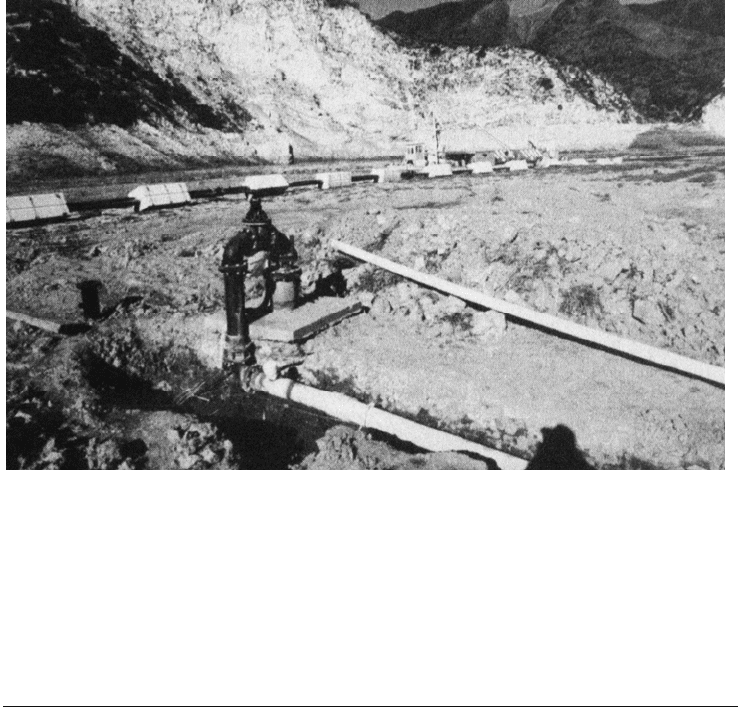
SEDIMENT ROUTING 13.21
FIGURE 13.13 Well drilled into empty Gibraltar Reservoir, California, during drought. The
photograph also shows dredging equipment left stranded by the drought (G. Morris).
were dry as was the heavily sedimented reservoir. The required water supply was obtained
from wells drilled through the silty reservoir deposits and into the permeable gravels in the
original river bed (Fig. 13.13).
13.9 SEDIMENT EXCLUSION
A sediment excluder is a device or system designed to route sediment along the river,
bypassing the intake. These intakes are an important feature at many water supply intakes
and hydropower diversion dams, and may also be used to supply offstream reservoirs. Use
of an intake configuration which minimizes sediment entrainment is an important
component of design. Sediment exclusion is discussed in more detail by the Committee on
Hydropower Intakes (1995), Raudkivi (1993), and Bouvard (1992). Complex three-
dimensional flow patterns occur in the vicinity of intakes, and physical modeling is
frequently employed in the design of large intake structures.
The distribution of coarse suspended sediment within moving water is not uniform but
tends to decrease exponentially as a function of distance above the bed. Sediment
excluders are designed to take advantage of this vertical variation in sediment
concentration to consistently withdraw water from zones within the flow field
characterized by relatively lower sediment content. The greater the variation in sediment
concentration within the water column, the more effectively an excluder will operate.
Exclusion will not be effective on slowly settling fines that are almost uniformly
distributed across the flow field. Zones of low sediment concentration may exist naturally
in the river or may be created by intake geometry. Suspended sediment exclusion can be
achieved by employing either flow curvature or flow partitioning to reduce suspended
sediment concentration in the intake.
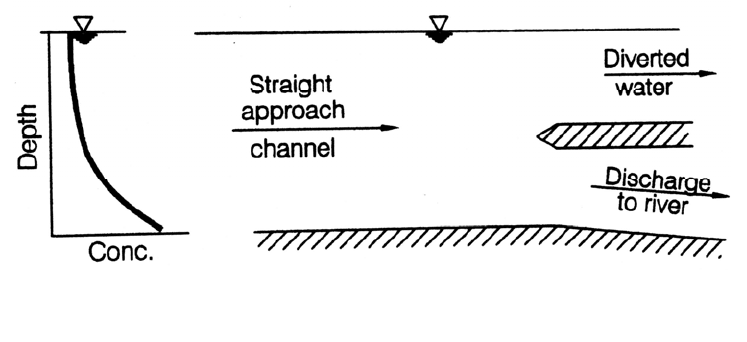
SEDIMENT ROUTING 13.22
13.9.1 Sediment Exclusion by Flow Partitioning
If water level can be maintained at a nearly constant elevation, upstream of a barrage for
example, the flow can be partitioned vertically. For example, vertical partitioning may be
accomplished by a two-level intake across a flow path and
perpendicular to the direction
of flow, at the end of a straight reach. The upper-level intake is used to divert clear water
and the sediment-laden bottom water is discharged downstream through a low-level outlet,
as schematically illustrated in Fig. 13.14. Similarly, a submerged weir running parallel to
the direction of flow will allow surface water to overflow toward the intake while the
deeper water and bed load continues downstream and bypasses the intake.
FIGURE 13.14 Sediment exclusion by vertical flow partitioning. Surface water with
lower sediment content is diverted to use while sediment-laden bottom water is discharged
back to the stream.
13.9.2 Sediment Exclusion by Flow Curvature
When flowing water is diverted at a curve, the water surface will become elevated at the
exterior of the curve because of momentum forces. Water at the surface flows faster than
water at the bottom, and
the greater momentum of the surface water carries it into the
exterior of the curve and forces the slower-moving bottom water out of the curve, creating
a transverse current. When this transverse current is superimposed on the downstream
direction of flow, the resulting current is helicoidal. As a result of this flow pattern, an
intake located at the outside of this curve will be continuously fed with surface water
while bottom water with higher sediment concentration is pushed out of the bottom of the
curve. This principle was employed 2000 years ago in constructing the Dujiangyan
irrigation diversion from the Min River in China.
The basic principle of flow curvature can be employed to construct a variety of intake
configurations, as illustrated in Fig. 13.15. Submerged vanes (e.g., Iowa vanes) can also be
used to produce flow curvature and otherwise modify sedimentation patterns in the
vicinity of intakes and can also modify current patterns to deflect erosive currents
and help
stabilize the river in the vicinity of structures (Odgaard and Wang, 1991).
13.9.3 Gravel Sluice
Gravel is not normally transported in suspension, but its gradual accumulation upstream of
a low dam which diverts water into an intake will eventually block the intake. This block-
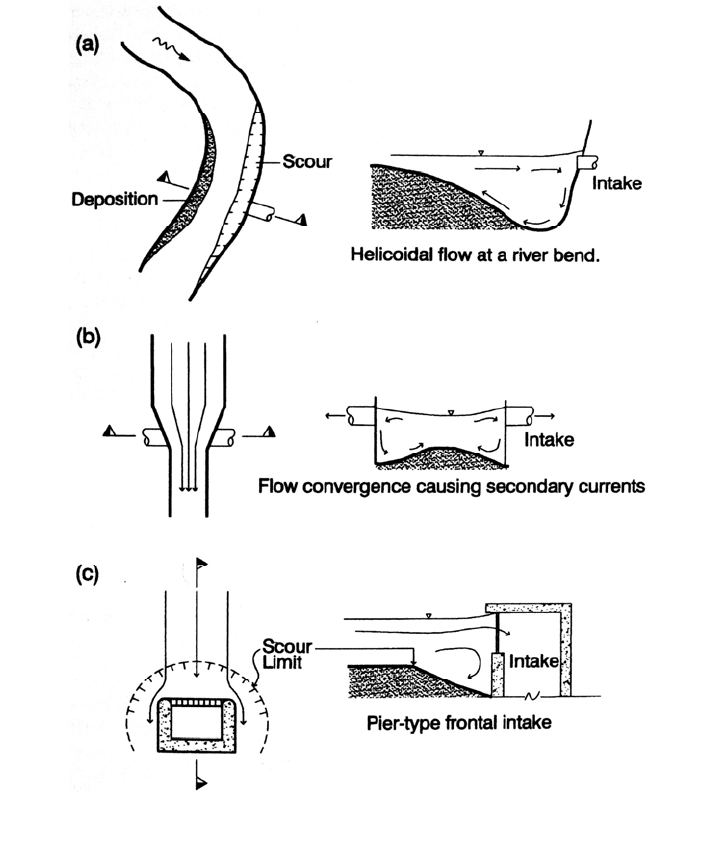
SEDIMENT ROUTING 13.23
FIGURE 13.15 Sediment-excluding intake configurations based on flow curvature: (a) helicoidal
flow at a river bend, (b) flow convergence, and (c) pier-type frontal intake.
age can be prevented by periodically flushing gravel from the immediate vicinity of the
intake using a sluicing system such as that illustrated in Fig. 13.16. In this illustration, the
low dam has a vertical sluice controlling flow along a sluice channel that passes
immediately in front of the intake. Opening the sluice removes bed material from the
vicinity of the intake, but no attempt is made to halt or otherwise manage the accumulation
of bed material behind the dam.
13.9.4 Intakes at Large Dams
Intake structures at dams should be designed to minimize problems of sediment
entrainment and eventual blockage by deposits. In some reservoirs, sediment can affect
low-level intakes soon after the dam is closed because of turbidity currents which reach
the dam. As the reservoir fills with sediment, delta deposits will eventually reach the dam,

SEDIMENT ROUTING 13.24
and coarse sediments can be transported to the vicinity of the intake as bed load. Several
strategies may be used to reduce sediment entrainment into intakes at the dam. Low-level
outlets may be established to facilitate hydraulic scour of sediment from the vicinity of the
intake, employing a concept similar to that illustrated in Fig. 15.18. Deep sluices can be
placed immediately below or adjacent to power intakes at the dam, and can be operated on
either a continuous or intermittent basis to reduce sediment entrainment into the intake, as
at Cachi Reservoir (Fig. 19.6).
13.9.5 Sediment Removal from Diverted Water
When sediment exclusion does not eliminate all the grains below the maximum allowable
size, exclusion may be complemented by systems to remove sediment from diverted water.
These systems are generally sized on the basis of the plain sedimentation of discrete
particles, but may also involve circular flow in which centrifugal force also aids in the
removal of sediment. Settling sediments are typically focused into a narrow slot or series
of orifices along the bottom of a sedimentation tank, then removed by either continuous or
intermittent discharge. A conceptual drawing of a rectangular sedimentation tank is
illustrated in Fig. 13.17.
13.10 COMPARTMENTED AND SERIAL RESERVOIRS
13.10.1 Reservoir Compartmentation
Operational flexibility for sediment management can be provided by dividing the total
storage volume into two components by using internal dikes or multiple reservoirs. For
example, use of a single seasonally empty reservoir may be infeasible because some
regulating storage is required during the nominally wet season. As an alternative, it may be
feasible to construct a larger seasonal-use on-stream impoundment which will receive a
heavy sediment load and a smaller offstream impoundment. During the wet season, only
the off-stream reservoir would be used while the on-stream reservoir remains empty for
sediment routing. Both would be available for dry season service. The off-stream
impoundment may consist of an arm of the reservoir that receives limited sediment input.
13.10.2 Reservoirs in Series
When more than one reservoir is constructed along a river, sediment released from an
upstream impoundment will be redeposited downstream unless all sites are managed
together. Sediments should be routed progressively through all reservoirs in series to
minimize the amount of redeposition in downstream impoundments. The reservoir pool
elevation at the downstream site affects the location of deposits, and one operational
objective for multiple reservoirs in series may be to focus deposition into areas which
facilitate subsequent removal. At some sites, such as small mountain hydropower
diversions upstream of a hydrologically large storage reservoir, it may not be feasible to
manipulate the downstream site and the released sediment may simply accumulate in the
downstream pool. This is the case for the reservoirs along the Feather River discussed in
Chap. 22; all the sediment routed through the small hydropower dams simply accumulates
in the large Oroville Reservoir further downstream.
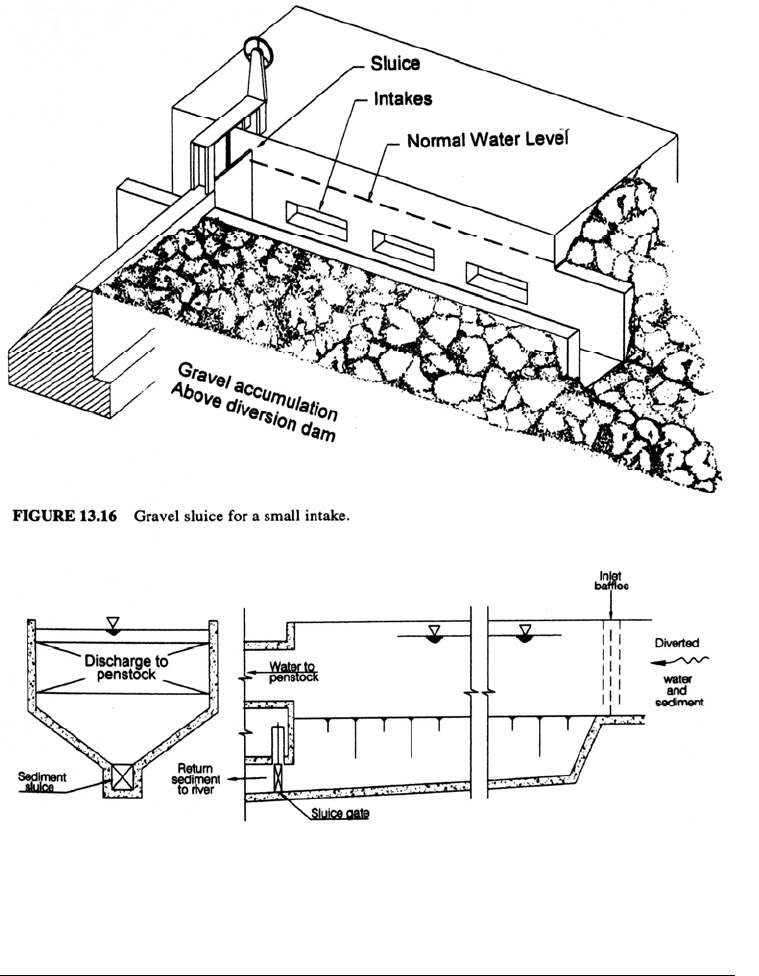
SEDIMENT ROUTING 13.25
FIGURE 13.17 Schematic diagram of rectangular settling tank or desander.
13.11 CLOSURE
A wide variety of routing strategies are available to achieve a sediment balance or to
minimize the rate of sediment accumulation. Routing strategies represent the least
environmentally disruptive method for maintaining long-term storage capacity in
reservoirs while minimizing the environmental impacts on fluvial systems. However,
environmental impacts cannot be entirely eliminated and may continue to be significant,
especially at in-stream reservoirs.
